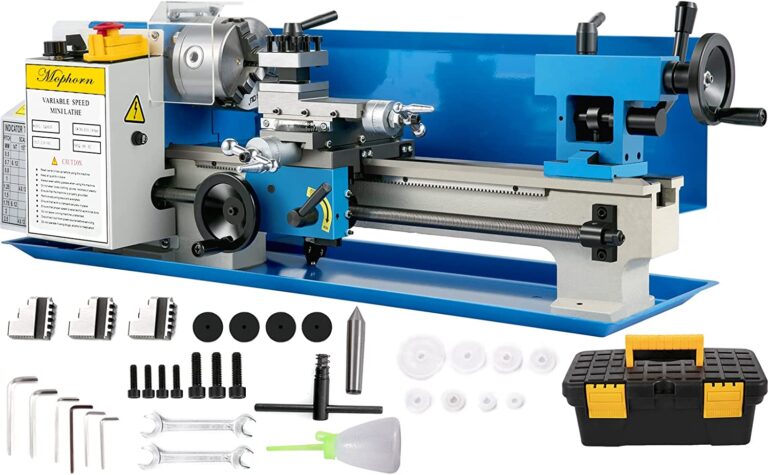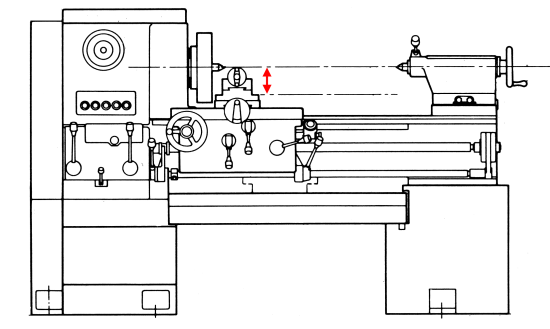4 Most Easy Metal Lathe Projects and How To Make Them
So Lathe is something that can be used to turn any metal and wood into anything. In this article, we will be discussing four hell of the easiest metal lathe projects that you can do on your own.
A skilled craftsperson can use a metal lathe to turn bare metal sheets into works of art.
A specific type of lathe that can be used for metalworking tasks is a metal lathe. Metal workpieces are significantly more powerful because they are more durable. They can violently twist and deform objects made of ordinary metals, including steel, iron, aluminum, and others.
It is a powerful piece of equipment that is commonly utilized in manufacturing applications involving metal workpieces. It is also known as a metalworking lathe.
Metal lathes use a hardened cutting tool attached to a revolving mounting surface. After being positioned on the lathe, the metal workpiece is cut with the help of a cutting tool that has been hardened.
Metal lathes can accommodate both wooden and non-wooden workpieces.
They are used to create screws, rifle barrels, metal music instruments, and a variety of other items, all of which are of a manageable size.
Let’s Talk Now about Metal Lathe Projects That Can Be Achieved
As mentioned above, lathes are used to make a variety of metal items. Some of the projects that can be done using Metal Lathes are Machinist’s Hammer, Screw Jack, Metal Scriber, Edge Clamps:
#1. Machinist’s Hammer
Handles on the Machinist’s Hammer are flat. Hold off on milling the flats until the hammer is complete and put together. Place it in a milling vise, after which you should grind one side and add a chamfer.
Make a hole in the handle’s base using a drill. You can use the hammer as a tiny cheater bar because it is used to fit Allen keys.
To achieve a hammer balance that is comfortable for you, you can make it shallower or deeper. Adjust the head and handle balance to be comfortable for the gentle tapping that this type of hammer is commonly used for.
Since brass is substantially heavier than aluminum, it can have two brass inserts instead of the standard one brass and one aluminum end.
It is an excellent project to practice lathe taper cutting.
Lock the compound rest at an angle and use a single setup to cut both tapers for cutting the self-holding tapers for the inserts. If the surface is smooth, the taper will last indefinitely. You can make the handle either with a taper attachment or an offset tailstock.
Requirements:
- 1.25′′ x 10.125′′ steel (1 pc)
- 1.25′′ x 2.125′′ steel (1 pc)
- 1.50′′ x 1.25′′ steel (2 pcs)
#2. Screw Jack
Screw jacks are a subclass of jacks that work by tightening a lead screw. Screw jacks usually self-lock, unlike hydraulic jacks, which need constant pressure to stay in their locked positions.
Use a cutting torch to cut the steel plate into three square pieces.
The size of each square should be four inches. Weld the pipe to the square to secure it. This will serve as the foundation plate for the screw jack and prevent it from falling over.
The hole in the second steel square needs to be somewhat bigger than the bolt’s diameter.
This will result in the cap plate. Using thread, connect the nut and bolt. Insert the bolt into the pipe’s open end. Cover the bolt’s head with the cap plate. Weld the cap plate onto the pipe. Make sure the nut and bolt assembly doesn’t get clogged up. The nut must be free to turn but should rest on the cap plate.
Attach the third steel square to the bolt head using welding. Turn the nut with a wrench to raise the screw jack’s top plate. The bolt’s threads will secure it in place. To lower the jack once more, oppositely turn the wrench.
Requirements:
- Wrench
- Steel plate
- 2-inch steel pipe
- Cutting torch
- Bolt, 6 inches long by 1 inch wide
- Nut
- Drill
- Welding rig
#3. Metal Scriber
A fantastic place to start with your metal lathe is with metal scribers.
When you need to mark a spot or draw a line on metal, a metal scriber is your go-to tool because it’s convenient and highly efficient. This metal scriber can be created using simple brass.
The brass must be faced and turned in your lathe to get the correct polished shape. As previously said, you require brass, preferably in the size of 2.5″.
Use a metal adhesive to join two pieces of metal. Additionally, be sure to have a steel sewing needle on hand.
You can polish and grind with an abrasive using the grinder. A grinder is a necessary instrument if you want to go further into the domain of raw metals.
Requirements:
- Brass
- Metal glue
- Tools for cutting and grinding steel seams
- Drilling bit
#4. Edge Clamps
When working with longer pieces of flat bar or plates, this compact set of clamps comes in help. Use 123 blocks to support your workpiece if you can maintain the 1′′ thickness accuracy.
Here is how they operate: When the jaws are loosened and pressed up against the workpiece, the centerline of the countersunk hole is moved away from the jaw.
The flat head screw tries to drive the jaw back into alignment so it can correctly seat when you tighten it. It produces a clamping force. It is advised to prepare them in groups of six.
Given that there are several of them to run, this may be a fantastic CNC job.
This project is advantageous for those who wish to learn how to drill, tap, countersink, and slot on a mill.
The body and jaws have been pulverized and heated. This opens your eyes to more inventive work techniques because not everything can be done in a milling vise.
To accommodate various processes and components, you can flip them around.
Try positioning the clamps at a 45-degree angle so that only a tiny portion of the base is supporting the part if you need to have some clearance under it for drilling through.
They can be utilized quite similarly to a typical toe clamp for thicker workpieces.
Requirements:
- 1.25 inch x 1.25 inch x 4.125 inch 4140 steel (x1 per clamp)
- 1.5 inch x 1.5 inch x 0.5 inch 4140 steel (x1 per clamp)
- Flat head socket cap screw, 1/2′′ UNC, length: 1inches (x1 per clamp)
We hope you liked these four projects, and the attached video tutorials will even make it easy for you to create these projects either as a hobbyist or pro.
Head down to the comments section to comment about any other project you made. Who knows! we may include that in our article.
Some FAQ’s to Let You Learn More About Lathes
Q. Can I turn wood on a metal lathe?
Yes, wood can be turned on a metal lathe. Wood, metal, plastic, and several other materials can all be shaped using a metal lathe. Even the best wood lathes shouldn’t be used to turn metal since you run the risk of damaging them.
Q. What can you produce using a metal lathe?
A lathe may be used to produce practically anything. Simple things like cups, carvings, spindles, pens, and pencils are just a few examples of what you can make! In addition to these heavy industries, metal lathes are employed in the automobile, aerospace, and shipbuilding sectors.
Q. How do small metal lathes generate revenue?
Metal lathe projects are popular on places like Etsy or eBay, where you can sell your crafts. Additionally, you might have success setting up shop at craft fairs. The most common buyers are machinists, jewelers, woodcarvers or sculptors, model builders, and other hobbyists.
Q. Which metal works best on a metal lathe?
It is possible to make anything out of any material, although some materials are more effective than others. The greatest metals to work with on a lathe include brass, stainless steel, and aluminum.
Q. What does a CNC lathe do?
CNC turning centers and lathes are very accurate and productive automated machine tools. It can process arcs, spirals, loops, worms, and other complex workpieces using linear interpolation as well as linear and oblique cylinders.
The ability to interpolate different compensation functions has a profitable effect on the production of complex parts in large quantities.
Q. What are the basic parts of a CNC lathe?
The basic parts of CNC lathes are a Hydraulic chuck and hydraulic tailstock, The tool holder of the CNC lathe, Milling powerhead.
Conclusion
The metal lathe is an incredible metal tool. Some claim that if the invention of the lathe had occurred earlier, humanity would have advanced by two to three hundred years.
Although more sophisticated products can be produced using a lathe, these tasks are the best ways to launch a career in this field.
One of the good things about manufacturing tools is that a lot of pride is put into craftsmanship, and you can very well still have them in your toolbox after ten or twenty years. Even though you might require more equipment, it will be worthwhile if you want to keep going.
Hi, my name is Charles Winn, A DIY enthusiast, Mechanical Engineer. I was born and raised in Springfield, Missouri. I am also a father of two troublemaker kids, a terrible photographer, and I love to play chess.








